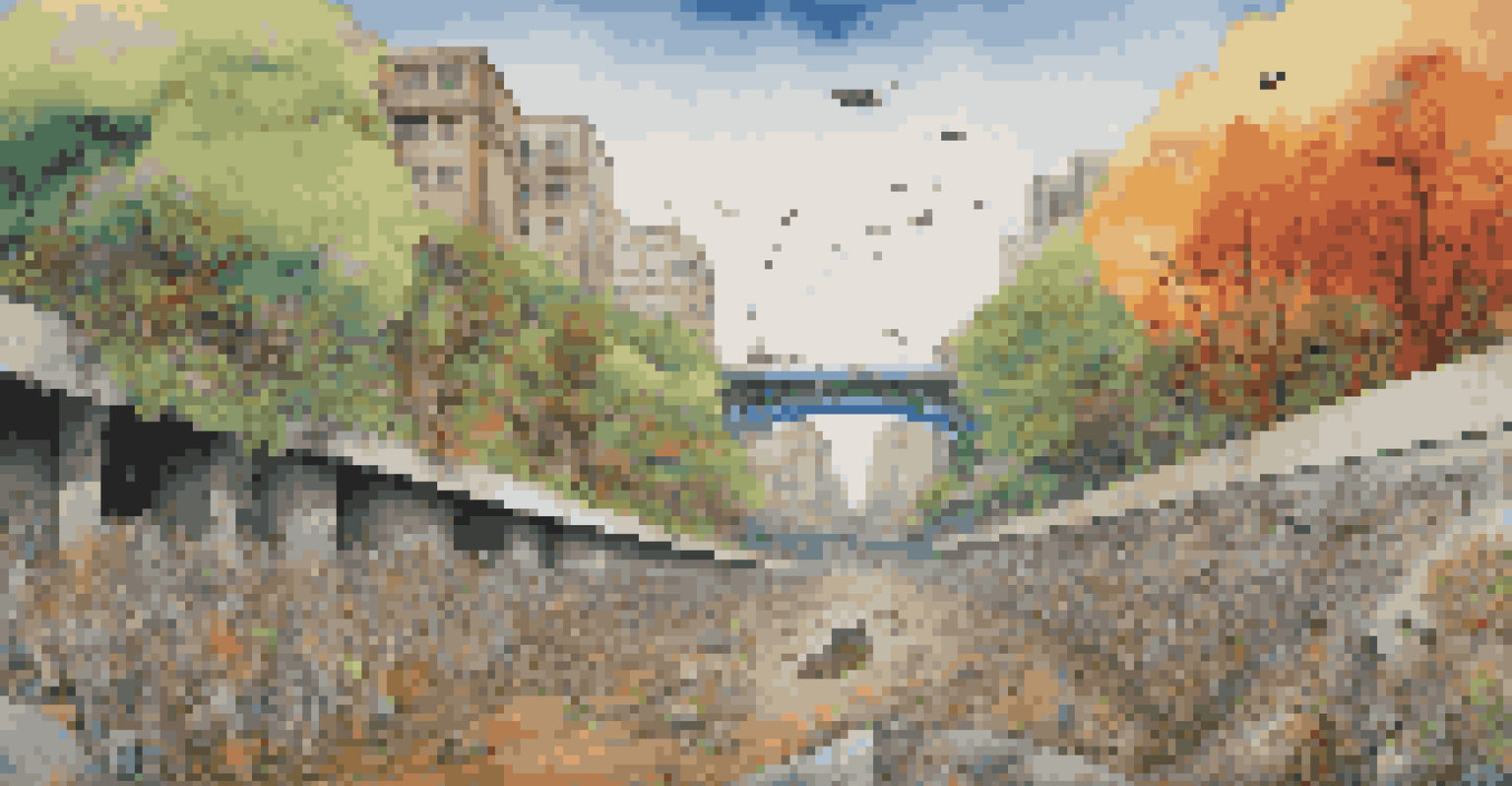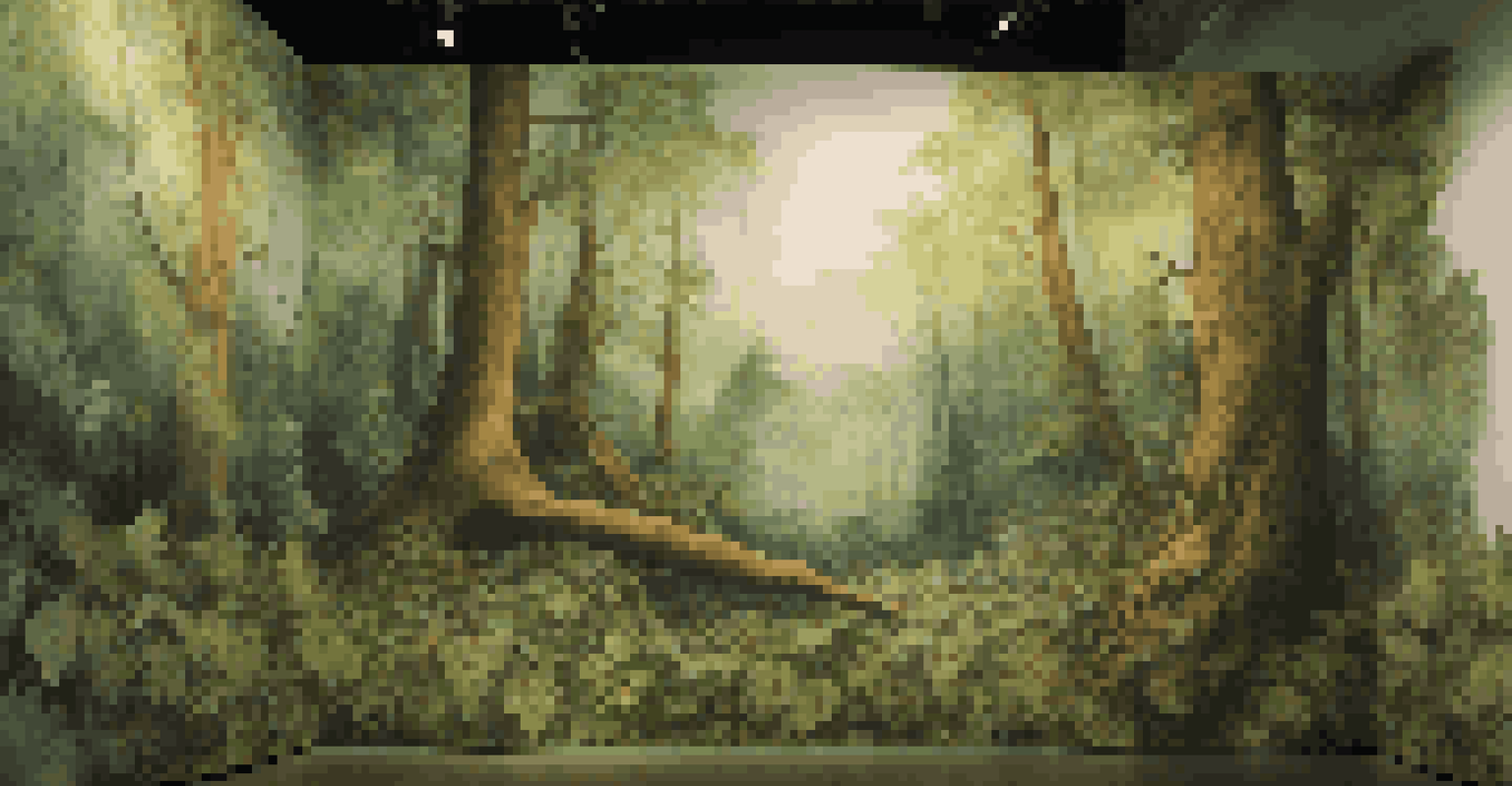Art and Environmental Awareness: A Contemporary Examination

The Intersection of Art and Environmental Issues
Art has always been a reflection of society, and today, environmental issues are at the forefront of many artists' minds. This intersection is not just a trend; it represents a crucial dialogue about our planet's future. Artists often use their platforms to highlight the consequences of climate change, pollution, and biodiversity loss, making these pressing topics accessible to a wider audience.
Art is not a mirror to hold up to society, but a hammer with which to shape it.
For instance, contemporary artists like Olafur Eliasson utilize natural elements in their installations to evoke an emotional response. By transforming spaces with light, water, and organic materials, they encourage viewers to reflect on their relationship with nature. Such experiences remind us that the environment is not a distant concern; it's an integral part of our everyday lives.
Thus, art becomes a powerful tool for raising awareness and inspiring action. Through visual storytelling, artists can make complex environmental issues tangible and relatable, fostering a deeper understanding of the challenges we face as a global community.
Art Movements Promoting Sustainability
Various art movements have emerged that focus specifically on sustainability and the environment. One such movement is Eco-Art, which emphasizes ecological consciousness and the importance of preserving our natural world. Artists involved in this movement often create works that highlight the beauty of nature while also critiquing human impact on the environment.

For example, the Land Art movement, which gained popularity in the 1960s and 1970s, involved creating large-scale outdoor sculptures using natural materials. Artists like Robert Smithson and Andy Goldsworthy crafted pieces that melded with the landscape, encouraging viewers to appreciate the beauty of the Earth while also acknowledging its fragility.
Art Amplifies Environmental Issues
Artists use their platforms to highlight urgent environmental challenges, making complex topics like climate change and pollution accessible to the public.
These movements not only raise awareness but also engage communities in environmental stewardship. By marrying creativity with ecological responsibility, artists can inspire collective action and foster a sense of responsibility toward our planet.
The Role of Public Art in Environmental Awareness
Public art plays a significant role in raising environmental awareness by engaging communities directly. Murals, sculptures, and installations in public spaces can serve as constant reminders of the importance of protecting our environment. When people encounter thought-provoking artwork in their daily lives, it sparks conversations and encourages reflection on environmental issues.
We do not inherit the earth from our ancestors, we borrow it from our children.
For instance, the mural 'The Earth is Our Home' in a bustling city center depicts a vibrant, thriving ecosystem juxtaposed with images of pollution and deforestation. This striking visual narrative compels passersby to consider their own impact on the environment. Such art not only beautifies urban landscapes but also serves an educational purpose.
Moreover, public art projects often invite community participation, fostering a sense of ownership and responsibility. When individuals contribute to these artworks, they invest in the message, making them more likely to advocate for environmental changes in their own lives.
Art as a Catalyst for Environmental Activism
Art can be a powerful catalyst for environmental activism, motivating individuals and communities to take action. Artists have the unique ability to inspire change through storytelling, using their work to convey urgent messages about climate change and conservation. Powerful imagery can evoke emotions and drive people to engage with environmental issues on a personal level.
Consider the global phenomenon of the 'Fridays for Future' movement, inspired by climate activist Greta Thunberg. Many artists have joined the cause, creating striking visuals and performances that amplify the message of climate urgency. This collaboration between art and activism not only raises awareness but also mobilizes people to participate in protests and advocacy efforts.
Sustainability in Art Movements
Movements like Eco-Art and Land Art emphasize ecological awareness and inspire community engagement through creative expression.
By leveraging creativity, artists can foster a sense of urgency and purpose, encouraging viewers to translate their emotions into action. This synergy between art and activism illustrates how creativity can play a vital role in shaping public opinion and driving societal change.
Digital Art and Environmental Consciousness
In today's digital age, artists are harnessing technology to promote environmental consciousness in innovative ways. Digital art offers new platforms for creative expression, allowing artists to reach global audiences instantly. Through social media and online exhibitions, art can inspire environmental awareness without the constraints of physical space.
For example, virtual reality (VR) experiences can immerse viewers in the beauty of untouched environments, contrasting them with the harsh realities of pollution and climate change. This immersive approach not only captivates audiences but also creates a lasting impact, encouraging viewers to consider their role in preserving these ecosystems.
Additionally, digital art can facilitate collaborations between artists and environmental organizations, amplifying messages and initiatives. By blending creativity with technology, artists can engage younger generations in environmental issues, fostering a sense of stewardship for the planet.
Art Education and Environmental Awareness
Art education plays a crucial role in fostering environmental awareness among young people. By integrating environmental themes into art curricula, educators can inspire the next generation of artists and activists. Students learn to use their creativity as a tool for advocacy, exploring concepts such as sustainability and conservation through various artistic mediums.
For instance, art programs that focus on upcycling materials teach students to see value in waste, encouraging them to think critically about consumption and waste management. This hands-on approach not only nurtures creativity but also instills a sense of responsibility toward the environment.
Digital Art Drives Activism
In the digital age, artists leverage technology to promote environmental consciousness and reach global audiences in innovative ways.
Moreover, exhibitions featuring student work centered on environmental themes can engage the wider community, sparking discussions about sustainability. By empowering young artists, we pave the way for a future where environmental consciousness is a fundamental aspect of creative expression.
The Future of Art and Environmental Activism
As we look to the future, the relationship between art and environmental activism will continue to evolve. With the increasing urgency of climate change and ecological degradation, artists will likely play an even more significant role in advocating for the planet. Their ability to communicate complex issues through compelling visuals will be essential in raising awareness and inspiring action.
Furthermore, as new technologies emerge, artists will have more tools at their disposal to engage audiences. From augmented reality to interactive installations, the possibilities for creating impactful environmental art are limitless. These innovations will allow for deeper connections between viewers and the issues at hand.

Ultimately, the future of art and environmental activism hinges on collaboration. By uniting artists, activists, and communities, we can harness the power of creativity to drive meaningful change and cultivate a sustainable future for our planet.